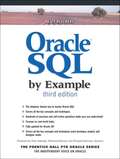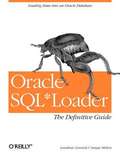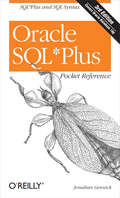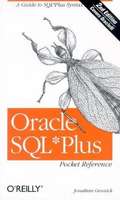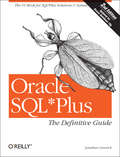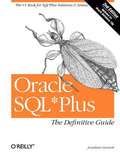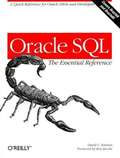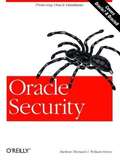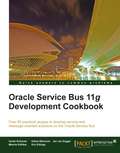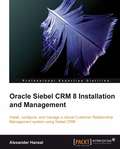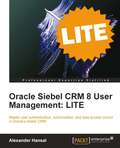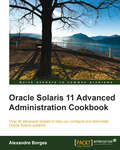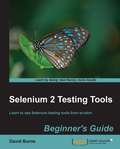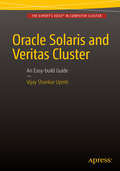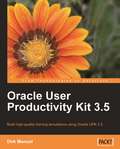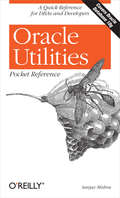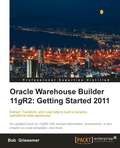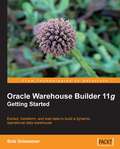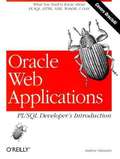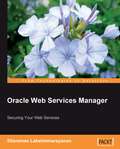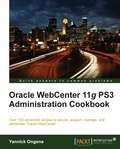- Table View
- List View
Oracle SQL by Example (3rd edition)
by Alice RischertOracle SQL by Example, Third Edition is a convenient, quick way to master Oracle SQL. This unique integrated book-and-Web learning solution teaches all the SQL skills you will need to succeed in an Oracle environment. Through hands-on, real-world labs, exercises, projects, and a superb Web-based training site, the book teaches administrators and programmers alike the core skills required for their jobs. Coverage includes every key Oracle SQL concept, including: entity-relationship diagrams, the SQL*Plus environment, SELECT and other statements, Boolean operations, joins, aggregate and not-aggregate functions. Each chapter contains review exercises that help the reader master the important skills before they move on.
Oracle SQL*Loader: The Definitive Guide
by Jonathan Gennick Sanjay MishraDespite the wide availability and use of SQL*Loader, few Oracle DBAs and developers know how powerful it really is. This book describes all of SQL*Loader's functions, including how to construct the necessary control files, load different types of data, and get the best performance. It covers the newest SQL*Loader features--the loading of large object (LOB) columns and the new object types (nested tables, varying arrays, and object tables).
Oracle SQL*Plus Pocket Reference
by Jonathan GennickThis pocket reference provides quick reference information that will help you use SQL*Plus, Oracle's interactive query tool. It summarizes all of the SQL*Plus syntax, including the syntax for new Oracle8 i release 8.1.6 features. SQL*Plus is available at every Oracle site--from the largest data warehouse to the smallest single-user system--and it's a critical tool for virtually every Oracle user. Despite its wide use, few developers and DBAs know how powerful a tool SQL*Plus can be. This book boils down the most vital information from Gennick's best-selling book, Oracle SQL*Plus: The Definitive Guide , into an accessible summary. It concisely describes interacting with SQL*Plus, selecting data, formatting reports with SQL*Plus, and tuning SQL queries. It also contains quick references to the SQL*Plus commands and format elements. This book is an indispensable companion to O'Reilly bestselling book, Oracle SQL*Plus: The Definitive Guide , but it does not replace it; the larger book is truly the definitive guide, suitable for readers at all levels of expertise. The definitive guide describes the many tasks that SQL*Plus can perform, and provides a tutorial on many SQL*Plus topics. But this quick reference is an excellent, portable resource for readers who want a pocket-sized summary of SQL*Plus capabilities and a reminder of how to issue specific commands and formatting options for SQL*Plus. Table of Contents: Interacting with SQL*Plus Selecting Data Formatting Reports Tuning SQL SQL*Plus Format Elements SQL*Plus Command Reference
Oracle SQL*Plus Pocket Reference, 2nd Edition
by Jonathan GennickThe new 2nd edition of our Oracle SQL*Plus Pocket Reference includes many new features for Oracle9 i (e.g., COALESCE function, searched CASE expressions, new table join syntax, partition operations, MERGE statement, and syntax changes in existing SQL*Plus statements such as ACCEPT, DESRIBE, HELP, and SET) It also adds sections on basic SQL (a much-requested feature): INSERT, DELETE, UPDATE, SELECT, and transaction management. The pocket reference size is especially appropriate for this particular subject, s
Oracle SQL*Plus Pocket Reference: A Guide to SQL*Plus Syntax (Pocket Reference (O'Reilly))
by Jonathan GennickThe Oracle SQLPlus Pocket Reference is a must-have for anyone working with Oracle databases, especially those looking to maximize the effectiveness of SQLPlus. As Oracle's long-standing interactive query tool, SQLPlus is available at every Oracle site, from the largest data warehouse to the smallest single-user system. Despite its wide use, however, SQLPlus is still often not completely understood or fully utilized.Database administrators and developers alike will therefore find the Oracle SQLPlus Pocket Reference to be extremely beneficial. In addition to summarizing all of the SQLPlus syntax and format options, including new Oracle Database 10g features, this handy, on-the-job guide specifically shows readers how to:Differentiate between SQL and SQLPlusInteract with SQLPlus from both the command line and the web browserSelect, insert, update, and delete dataFormat both text and HTML reports with SQLPlusSpecify SQLPlus commands and format elementsTune SQL queriesThe new third edition of this book has been updated for Oracle Database 10g to include information on both SQLPlus and SQL. New SQL information includes the SELECT statement's new MODEL clause, flashback queries, partition outer joins, and DBMS_XPLAN.With its quick-reference format and compact size, the Oracle SQLPlus Pocket Reference follows in the long line of successful "pocket references" offered by O'Reilly. It also serves as the ideal companion to O'Reilly's larger, more comprehensive book on SQLPlus, the bestselling Oracle SQLPlus: The Definitive Guide.Author Jonathan Gennick is an editor for O'Reilly specializing in database and programming titles, having amassed some 17 years of programming and database management experience.
Oracle SQL*Plus: The Definitive Guide
by Jonathan GennickDespite its wide availability and usage, few developers and DBAs have mastered the true power of Oracle SQLPlus. This bestselling book--now updated for Oracle 10g--is the only in-depth guide to this interactive query tool for writing SQL scripts. It's an essential resource for any Oracle user.The new second edition of Oracle SQLPlus: The Definitive Guide clearly describes how to perform, step-by-step, all of the tasks that Oracle developers and DBAs want to perform with SQLPlus--and maybe some you didn't realize you could perform.With Oracle SQLPlus: The Definitive Guide, you'll expertly:write and execute script filesgenerate ad hoc reportsextract data from the databasequery the data dictionary tablescustomize an SQLPlus environmentand much moreIt also includes a handy quick reference to all of its syntax options and an often-requested chapter on SQL itself, along with a clear, concise, and complete introduction.This book is truly the definitive guide to SQLPlus. It's an indispensable resource for those who are new to SQL*Plus, a task-oriented learning tool for those who are already using it, and an immediately useful quick reference for every user. If you want to leverage the full power and flexibility of this popular Oracle tool, you'll need this book.
Oracle SQL*Plus: The Definitive Guide, 2nd Edition
by Jonathan GennickDespite its wide availability and usage, few developers and DBAs have mastered the true power of Oracle SQL*Plus. This bestselling book--now updated for Oracle 10g--is the only in-depth guide to this interactive query tool for writing SQL scripts. It's an essential resource for any Oracle user. The new second edition of Oracle SQL*Plus: The Definitive Guide clearly describes how to perform, step-by-step, all of the tasks that Oracle developers and DBAs want to perform with SQL*Plus--and maybe some you didn't realize you could perform. With Oracle SQL*Plus: The Definitive Guide , you'll expertly: write and execute script files generate ad hoc reports extract data from the database query the data dictionary tables customize an SQL*Plus environment and much more It also includes a handy quick reference to all of its syntax options and an often-requested chapter on SQL itself, along with a clear, concise, and complete introduction. This book is truly the definitive guide to SQL*Plus. It's an indispensable resource for those who are new to SQL*Plus, a task-oriented learning tool for those who are already using it, and an immediately useful quick reference for every user. If you want to leverage the full power and flexibility of this popular Oracle tool, you'll need this book.
Oracle SQL: The Essential Reference
by David C. KreinesEverything Oracle developers and DBAs need to know about standard SQL (Structured Query Language) and Oracle's extensions to it is in this single, concise reference volume. Quick-reference chapters investigate basic SQL elements, Data Definition Language (DDL) and Data Manipulation Language (DML), SQL functions, PL/SQL, SQL*Plus, and Oracle SQL optimization and tuning. The book covers Oracle8 i, release 8.1.6.
Oracle Security
by William Heney Marlene TheriaultThis book covers the field of Oracle security from simple to complex. It describes basic RDBMS security features (e.g., passwords, profiles, roles, privileges, synonyms) and includes many practical strategies for securing an Oracle system, developing auditing and backup plans, and using the Oracle Enterprise Manager and Oracle Security Server. Also touches on advanced security features, such as encryption, Trusted Oracle, and Internet and Web protection.
Oracle Service Bus 11g Development Cookbook
by Guido Schmutz Edwin BiemondThis cookbook is full of immediately useable recipes showing you how to develop service and message-oriented (integration) applications on the Oracle Service Bus. In addition to its cookbook style, which ensures the solutions are presented in a clear step-by-step manner, the explanations go into great detail, which makes it good learning material for everyone who has experience in OSB and wants to improve. Most of the recipes are designed in such a way that each recipe is presented as a separate, standalone entity and reading of prior recipes is not required. The finished solution of each recipe is also made available electronically. If you are an intermediate SOA developer who is using Oracle Service Bus to develop service and message-orientated applications on the Oracle Service Bus, then this book is for you. This book assumes that you have a working knowledge of fundamental SOA concepts and Oracle Service Bus.
Oracle Siebel CRM 8 Developer's Handbook
by Alexander HansalThis book uses a real-life case study to provide easy-to-follow examples that are radically practical and can be easily adapted to similar situations in Siebel CRM implementation projects.The book ensures that you know what you are doing and why you are doing it by providing useful insight along with detailed practical instructions. It contains a multitude of explanatory tables, screenshots, and precise diagrams to illustrate the topics.When you have finished the book you will feel prepared to participate in Siebel CRM implementation projects. In addition you will be able to teach the "old dogs" some new tricks.This book is written for developers who want to develop their Siebel Tools skill set. While the book is intended for beginners, even experienced developers will benefit from the topics presented in this book. Preliminary exposure to or training on technical Siebel topics would be beneficial but is not mandatory before you start reading this book.
Oracle Siebel CRM 8 Installation and Management
by Alexander HansalThis book provides a practical, hands-on experience. Chapter by chapter, a Siebel CRM self-study environment is created which can be used to follow the examples described in the book to explore the Siebel functionality. The book ensures that you understand what you are doing and why you are doing it. It contains clear step-by-step instructions, explanatory tables, screenshots, and precise diagrams. This book is for administrators who want to develop and strengthen their Siebel CRM skills in the areas of installation and system management. Whether you are a novice or a more experienced user, this book will teach you something new in many ways and by the end of the book, you will be ready to install and manage Siebel CRM in a real-world environment.
Oracle Siebel CRM 8 User Management: LITE
by Alexander HansalThe book ensures that you know what you are doing and why you are doing it by providing useful insight along with detailed practical instructions. It contains a multitude of explanatory tables, screenshots, and precise diagrams to illustrate the topics. The material has been carefully selected from Packt's fuller 572 page Oracle Siebel CRM 8 Installation and Management. The book is written with the role of an application administrator in mind who wants to deepen her or his understanding on how user authentication, authorization, and user management are carried out correctly in Siebel CRM.
Oracle Solaris 11 Advanced Administration Cookbook
by Alexandre BorgesIf you are a Solaris administrator who wants to learn more about administering an Oracle Solaris system and want to go a level higher in utilizing the advanced features of Oracle Solaris, then this book is for you. A working knowledge of Solaris Administration is assumed.
Oracle Solaris 11: First Look
by Philip P. BrownThis book is written in simple, easy-to-understand format with lots of screenshots and step-by-step explanations. If you are a Solaris administrator looking for a step-by-step guide to understand the new features and functionality of Oracle Solaris 11, then this is the guide for you. Working knowledge of Solaris is required.
Oracle Solaris and Veritas Cluster
by Vijay Shankar UpretiLearn the fundamental concepts of OS clustering, Oracle Solaris clustering high-level design, Oracle Solaris clustering implementation using VirtualBox, and Veritas clustering implementation using VirtualBox. Oracle Solaris and Veritas Cluster: An Easy-build Guide shows you how to implement a cluster on your desktop or laptop devices using virtualized network, host, and storage configuration. This book explains both the architecture design and technical implementation for building Solaris Oracle- or Veritas-based clustered environments. This book provides snapshot-based steps to set up Solaris virtual hosts under VirtualBox and implement Veritas clustering across two virtual hosts that can be implemented on a desktop or laptop. This book will help you understand what it's like setting up a clustered environment, in simple steps that can be followed by users having little knowledge of clustering. What You Will Learn: Practice cluster implementation on your local PC or laptop Implement both Oracle/Solaris and Veritas clusters under Oracle Solaris 10 OS Master cluster fundamentals, concepts, and design Create virtualized environments under VirtualBox Learn the prerequisites and configuration for host builds, networking, and storage setup using VirtualBox for Solaris Oracle and Veritas Who This Book Is For: IT support engineers, education institutions and students.
Oracle User Productivity Kit 3.5
by Dirk ManuelThis book provides a practical tutorial on UPK's functionality, with the aim of teaching developers how to best leverage this functionality to develop high-quality training material. The book guides readers from the basics of recording through to adding value through Web Pages Packages (Infoblocks), Role filters, Glossaries, and more. The book starts with the recording of a simple simulation, and builds on this recording throughout, by introducing new UPK features and incorporating the lessons learned into this recording. Interwoven into this, the key tasks (how-tos) are formatted in such a way that they can be quickly identified and referred to, making this book useful as an ongoing reference to UPK functionality. This book has been written primarily for new or intermediate training developers who will be using Oracle UPK or OnDemand to create their training material. If you are an experienced UPK developer who wants to tailor UPK to meet your own, specific requirements, you will love this book.
Oracle Utilities Pocket Reference: A Quick Reference for DBAs and Developers
by Sanjay MishraThe Oracle Utilities Pocket Reference is a handy, quick-reference guide to the multitude of Oracle utilities that database administrators (DBAs) use every hour of every day.As the undisputed leader among database products, Oracle is grasped conceptually by most DBAs. However, they understandably may not recall the specific utility to use for a given task, and, more commonly, won't in many cases remember the syntax to use. And that's exactly what the Oracle Utilities Pocket Reference supplies--the syntax and options for whatever utility a DBA needs to perform a given task.Some of the utilities documented in this guide include:SQL*Loader, for loading dataexpdp and exp for exporting data to another databaseoradebug for use in troubleshootingloadjava and dropjava for loading and unloading Java programsPacked with information in an easy-to-read format, this valuable resource is ideal for any experienced DBA. Even database programmers who deal with Oracle will truly appreciate having the Oracle Utilities Pocket Reference close at hand.Authored by Sanjay Mishra, a foremost authority on Oracle systems, this convenient and compact guide is focused and to-the-point, eliminating any potential guesswork or difficult memorization. The Oracle Utilities Pocket Reference is part of the strong-selling collection of O'Reilly "pocket reference" books.
Oracle VM Manager 2.1.2
by Tarry SinghThis is a practical, hands-on book with precise, step-by-step instructions. We go about installing Oracle VM Servers and Oracle VM Manager. The writing style is conversational and the book also gives you a graphical view of the steps that are carried out. The book starts by looking at the important features of virtualization and then takes you directly to installation. The motive is to get you started right away and have you excited enough to use the complete book as an essential guide to not only learning but implementing your Oracle VM farm within your data center. This book is for anyone who wants to learn virtualization with Oracle VM Manager and has some understanding and experience with virtualization; it is not an introductory book on virtualization but goes into detail explaining Oracle VM Servers and managing those VM Servers with Oracle VM Manager. The book is aimed at IT managers or administrators looking to learn a new set of skills to enhance their careers as well as those looking for more consolidated and comprehensive tools to manage virtual infrastructures. It will be helpful to VMware, Microsoft, and other virtualization administrators who are looking for robust and cheaper alternatives to otherwise expensive and proprietary virtualization software. Generally IT managers and non-core-IT staff may also benefit from chapters that teach how to manage the life-cycle of VMs and generally integrate the technology process into the people and processes of their organization.
Oracle Visual Builder Cloud Service Revealed: Rapid Application Development for Web and Mobile
by Sten VesterliBuild and deploy an attractive, user-friendly web or mobile application in one day or less using Oracle’s new, low-code development tool: Visual Builder Cloud Service.Today’s IT world is fast-paced, and the ability to rapidly deliver running code is the most crucial and sought-after skill a developer can have. Oracle has brought together their enterprise experience, advanced usability knowledge, and their best cloud engineering to produce an innovative platform giving developers unprecedented productivity.You will learn how to use all aspects of Oracle Visual Builder Cloud Service to build web or mobile applications. Using the fully browser-based development environment, you’ll gain experience with all the modern user-interface components that the tool offers for a visual, user-interface-driven, development approach. You'll also see how to use the integrated data management capabilities and existing REST data services to store your data, and learn how to easily transfer applications to a test/staging environment and later to production, while continuing to develop the next version in the development environment.What You'll LearnBuild great-looking web and mobile applications in a browser-based, visual design environmentDefine custom business logic in the visual logic editor or with JavaScriptManage multiple concurrent application versions from development through staging and productionDefine business objects with validation logic for application-specific dataCommunicate with, and draw data from, existing REST web servicesUse Visual Builder Cloud Service to expand Oracle SaaS solutionsWho This Book Is ForDevelopers at all expertise levels as well as business professionals and UX designers with an interest in using IT to quickly solve simple business problems. Because this tool is based on a modern low-code approach, no prior programming experience is necessary to benefit from the book.
Oracle Warehouse Builder 11g R2: Getting Started 2011
by Bob GriesemerThis easy-to-understand tutorial covers Oracle Warehouse Builder from the ground up, and taps into the author's wide experience as a software and database engineer. Written in a relaxed style with step-by-step explanations, lots of screenshots are provided throughout the book. There are numerous tips and helpful hints throughout that are not found in the original documentation. By following this book, you can use Oracle Warehouse Builder in the best possible way and maximize your learning potential. This book is an update of Oracle Warehouse Builder 11g: Getting Started. This book is a good starting point for database engineers, administrators, and architects who are responsible for data warehouse projects and need to design them and load data into them. If you are someone who wants to learn Oracle Warehouse Builder and expand your knowledge of the tool and data warehousing, this is an ideal book for you. No prior data warehouse or database experience is presumed. All new database and data warehouse technical terms and concepts explained in clear easy-to-understand language.
Oracle Warehouse Builder 11g: Getting Started
by Bob GriesemerThis easy-to-understand tutorial covers Oracle Warehouse Builder from the ground up, and taps into the author's wide experience as a software and database engineer. Written in a relaxed style with step-by-step explanations, lots of screenshots are provided throughout the book. There are numerous tips and helpful hints throughout that are not found in the original documentation. By following this book, you can use Oracle Warehouse Builder in the best possible way and maximize your learning potential. This book is a good starting point for database engineers, administrators, and architects who are responsible for data warehouse projects and need to design them and load data into them. If you are someone who wants to learn Oracle Warehouse Builder and expand your knowledge of the tool and data warehousing, this is an ideal book for you. No prior data warehouse or database experience is presumed with all new database and data warehouse technical terms and concepts explained in clear easy-to-understand language.
Oracle Web Applications: PL/SQL Developer's Introduction
by Andrew OdewahnThis book is an easy-to-understand guide to building Oracle8i (Oracle's "Internet database") Web applications using a variety of tools -- PL/SQL, HTML, XML, WebDB, and Oracle Application Server (OAS). It also covers the packages in the PL/SQL toolkit and demonstrates several fully realized Web applications. This book provides the jump-start you need to extend relational concepts to Web content and to make the transition from traditional programming to the development of useful Web applications for Oracle8i.
Oracle Web Services Manager
by Sitaraman LakshminarayananThis is the book for those who want to learn how to: Secure web services Use Oracle WSM to configure web services security It is mainly for Developers and Architects who want to learn how to use Oracle WSM to address the security challenges of web services and those who want to learn how to use Oracle WSM to address their security needs. If you have a basic knowledge of web services then this book will help you understand the need for security and how to use Oracle WSM to address the security challenges.
Oracle WebCenter 11g PS3 Administration Cookbook
by Yannick OngenaThis is a cookbook filled with numerous recipes for learning important and advanced aspects of administering WebCenter.If you are a WebCenter administrator who wants to keep up to date with the newer version, and learn all the important and advanced aspects of administering WebCenter then this book is for you. You need to have WebCenter installed and to have basic knowledge of administering WebCenter.
